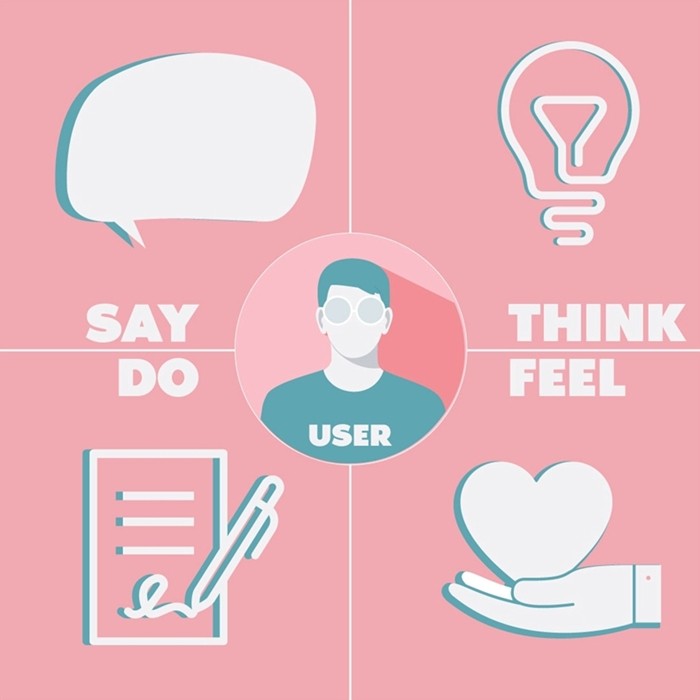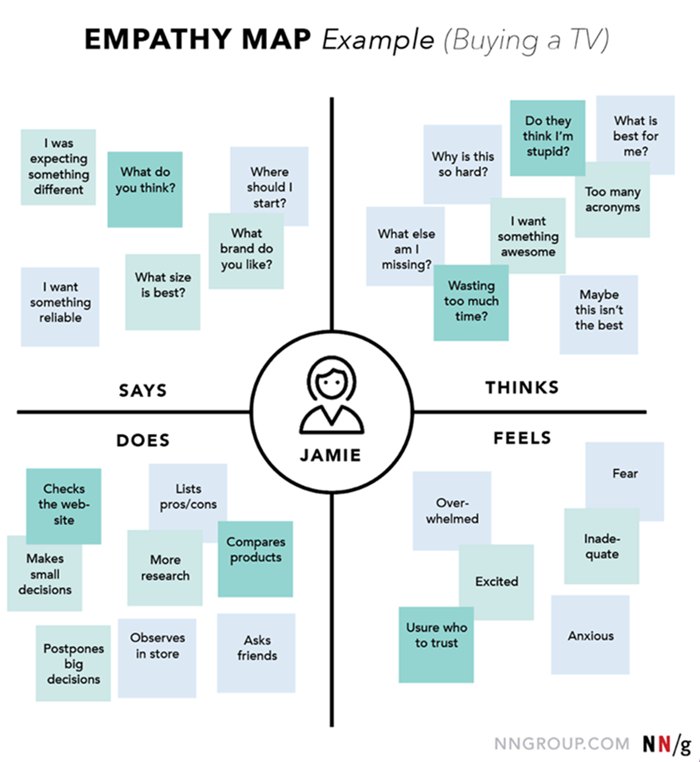Have you noticed that the best books and movies are so totally immersive you feel as if you’ve actually entered the world they depict? Which is why I’d argue that the people most skilled in content aren’t necessarily the best writers; rather, they’re the ones who are able to empathize with characters so well that their creations seem real.
When writing for marketing, you need to connect with your audience. But first you have to understand who they are and what they care about. That’s where empathy mapping comes in.
What Is an Empathy Map?
An empathy map is a tool that brings to light to your most likely customers. It teaches you how to connect with the people who will consume your content, products, or services.
Typically divided into quadrants of say, think, do, and feel, the empathy map is intended to get into the head—and heart—of the customer. It helps you to visualize that what someone says doesn’t always align with what they do. That’s why it’s also important to understand what they think and feel.

For example, someone might say they love the service you provide, yet still shun your products. Could it be that the cost is too high, and in their social circles that may not be something they’re willing to say? Or maybe they feel passionately about your products but think the purchase isn’t practical.
Unfortunately, those conflicting “boxes” in the empathy map are the norm: Human life is rife with examples of cognitive dissonance that make little sense if you think purchase decisions follow the 19th century buyer funnel of attention-interest-desire-action. They don’t.
Which is all the more reason to really understand what might motivate your users.
Interestingly, empathy maps are already common in the design industry. Tech experts in user experience and agile design use empathy maps to help them enhance user satisfaction. Whether they design new products, software, or websites, they want to come as close to what the user wants as possible—so they try to empathize with them.
If the tech experts get it, why don’t the rest of us?
Because digital allows us to measure the success of every piece of content we create and disseminate, even the most naturally empathetic writers among us may have shifted away from our instincts. We want our videos, pages, and posts to rank. We want to please the Google gods and all their algorithmic updates.
But, the thing is, Google’s goal has always been to act more human. Every algorithm is another effort to provide users with the best experience possible.
It’s time to get back to human. And empathy mapping can help.
How to Get Started
Set some goals
But not just your own goals.
Sure, you need to know that this empathy mapping exercise has a purpose. And like every business class ever taught you, your goals should be SMART: specific, measurable, achievable, relevant, and time-bound. Now consider the single user or the group of users you will target with your map, the action you want them to take, and how you might best get there. But if the goal of empathy mapping is to empathize (and it is), then the goals you should really consider are those of your audience:
- What about your content will appeal to users?
- What is it about your product that is uniquely suited to accomplish their goals?
- What do they care about?
- Who are they?
There’s so much you can do with content to give users a better experience, and it’s not just about the actual content. How you produce it matters, as well.
For example, did you know that up to 43 million Americans are dyslexic? Create blog posts that are visually easy to read, and you make them more accessible to those readers. Include easy headers, bold font, and simple-to-digest paragraphs. It helps millions of people get your content. Bonus: it’s sound SEO practice.
Gather data
Ah, data is involved! No wonder techies use empathy maps.
Pull data from multiple sources:
- Start with Google Analytics to learn the demographics and psychographics of people who come to your website and consume your content.
- To infer user intent, use Google Search Console to see the keywords that get you clicks. And be cognizant about where in the buyer journey those users are.
- Do you advertise on Facebook? The platform’s Audience Insights offers a trove of data.
- And tools that help you measure SEO success (like SEMrush) help you see what your competitors are doing for their SEO.
- Get granular and pull actual customer data from your own CRM.
- Then move onto broader insights: Look at national consumer trends for your products. Google’s Consumer Barometer tool is an easy place to start, but don’t neglect economic trends and the info you can find in trade magazines and industry publications.
The more data you have, the more you can understand your consumer and where they fit—in the empathy map and in the larger world.
Build from your current personas
If you’re selling anything to anyone, you’ve probably already built out a way to market to them. And that usually involves creating buyers personas. There’s no need to trash good work. Take a critical look at what you already know about your ideal consumer and how they interact with your content and build upon it.
Add Anecdotal Evidence
Understanding the story behind your users is the whole point of empathy mapping, so speak to your actual customers. Perform interviews, enlist researchers, conduct surveys. Ask questions about who they are, where they’re from, and, most importantly, why they do the things they do, especially when it comes to what they choose to read, view, and buy. And make sure to talk to the people who talk to your customers. What do your salespeople say? What about customer service reps? Listen to their stories and add them to your empathy mapping.
Fill in Your Map
Or maps. Much like you don’t have a single buyer persona, you may produce multiple maps over time. Take all that data and put the information in the appropriate boxes/quadrants. Here’s how the Interaction Design Foundation outlines that process:
- What do they say? Write down important quotes and keywords potential customers used.
- What do they do? Describe their actions and behaviors.
- What do they think? What might they be thinking? What are their motivations, goals, needs, desires? What does all that say about their values and beliefs?
- How do they feel? What emotions might they be feeling? Consider their body language, their choice of words, their tone of voice.
When filling out the map, don’t get mucked up in the details. If you’re not sure if a data point is a “think” or a “feel,” just pick one. This exercise is more art than science. What you’re trying to do is immerse yourself in the user’s world—much like you’re able to do in those great movies and books.
Here’s an example of a completed empathy map from the Nielsen Norman Group (NN/g):

Draw Some Conclusions
Actually, you’re not looking for conclusions so much as hypotheses about your users.
Take the retrospective information you gathered from your mapping exercise, and build out prospective mapping. You’re in their world now, so imagine what-if scenarios that connect your users to your content.
What story can you tell that will appeal to them? What kind of content can you produce to engage, educate, and entertain?
Those Discover credit card commercials have the right idea with their “We treat you like you’d treat you” tagline. Genius! And how empathy works.
Share Your Mapping
Empathy maps are great tools for creating great content. But they’re also important for those people in Sales and Customer Service. Oh, and Product Development!
Don’t hoard all the valuable information you’ve discovered about your customers. Spread the news companywide.
Iterate and Improve
You’re not done. Empathy maps should continually evolve as you gather more information and insight. Review your maps on a quarterly basis. Tweak, add, improve.